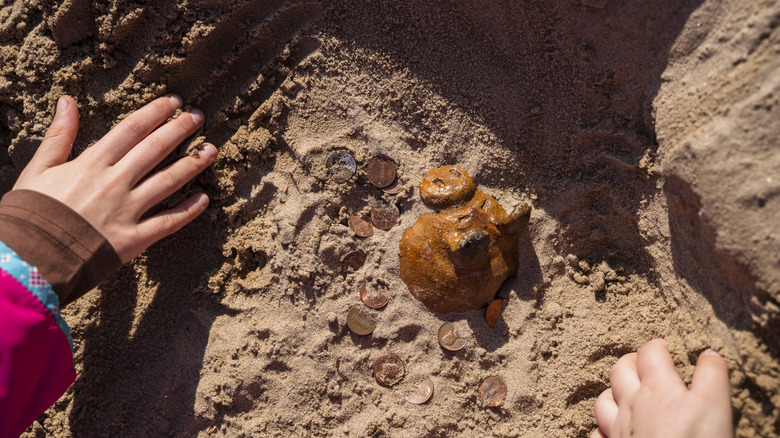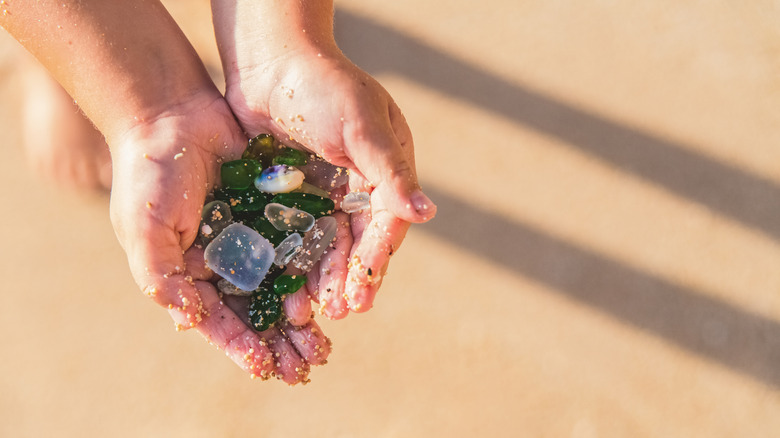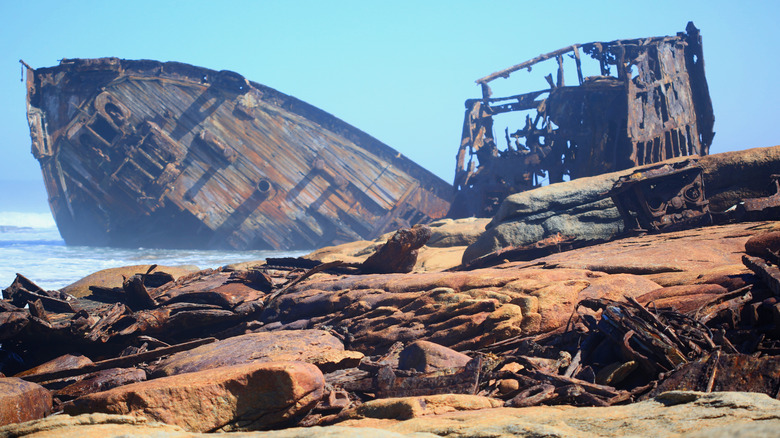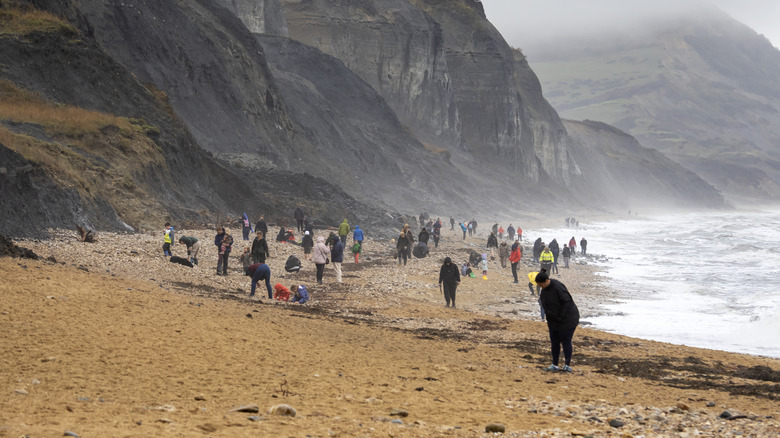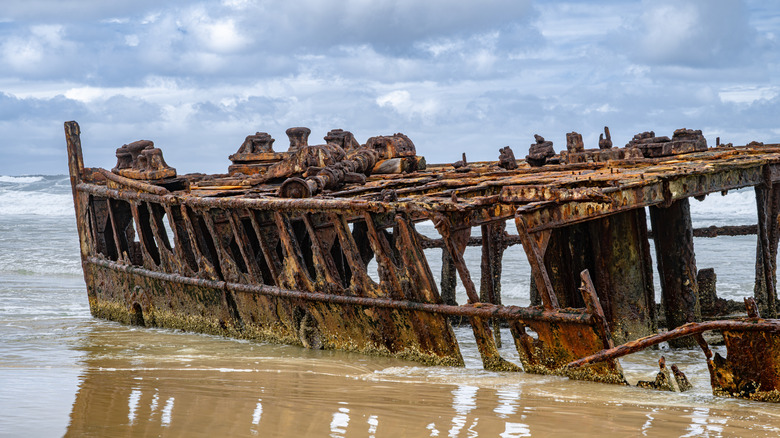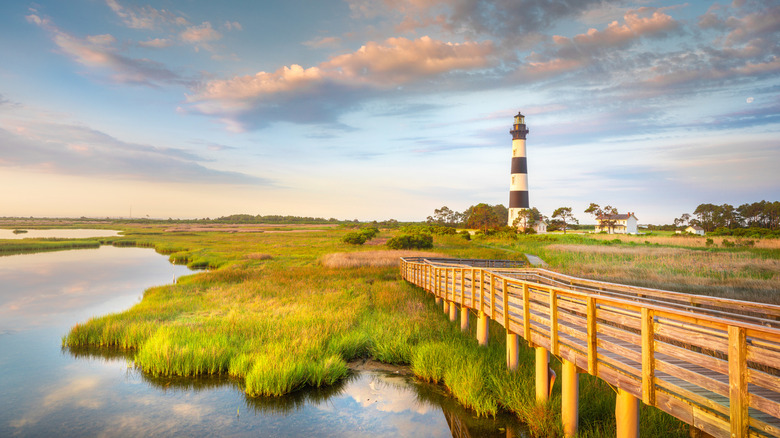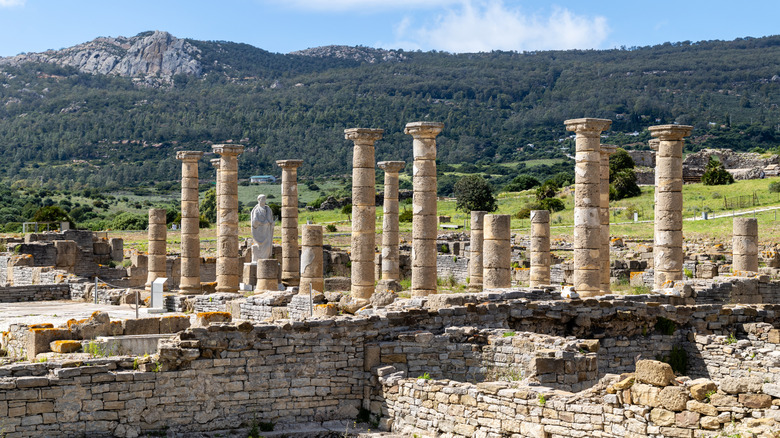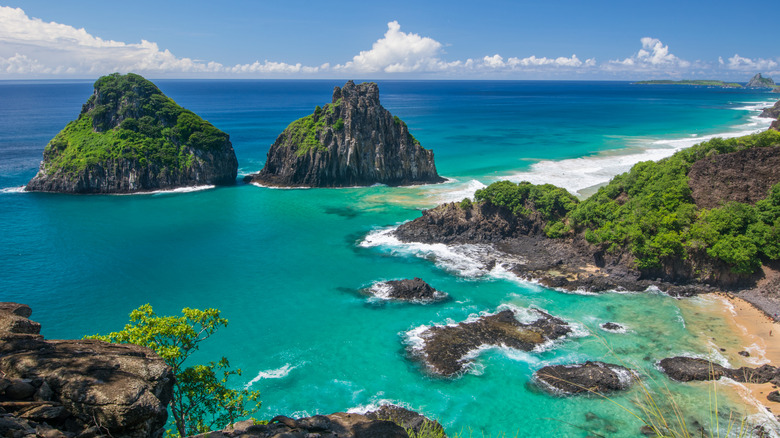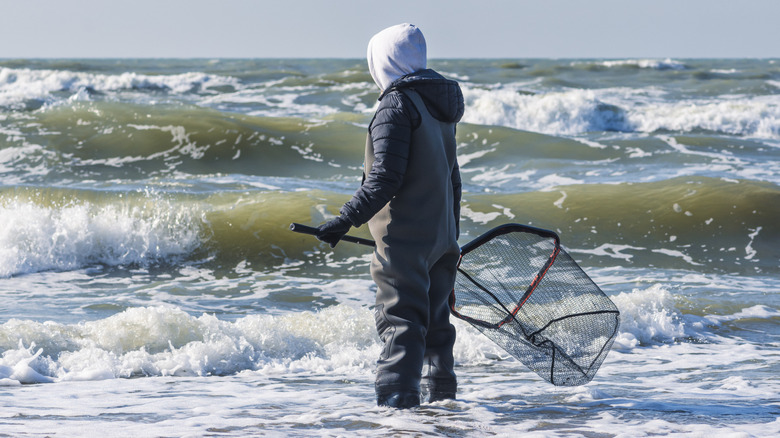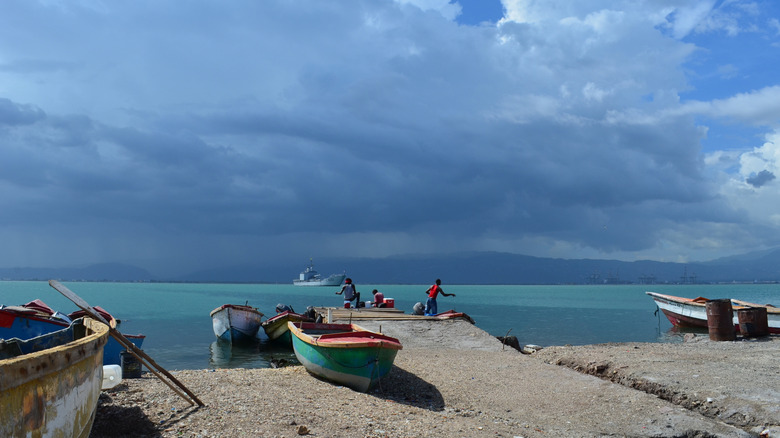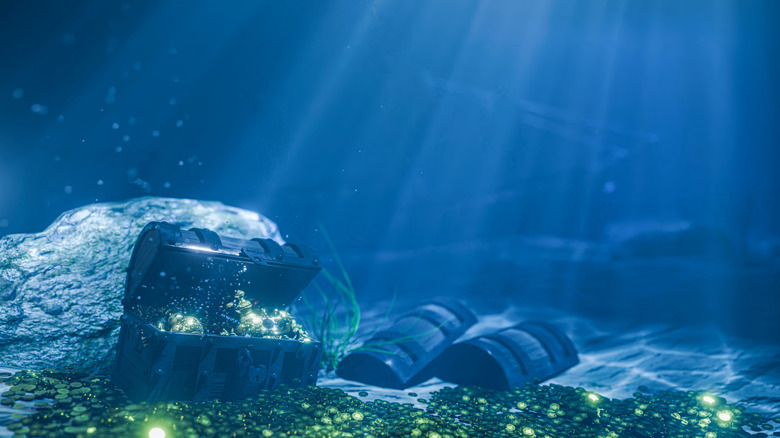The Best Beaches Around The World For Treasure Hunting, According To Research
Most of us have fantasized about finding treasure at some point in our lives. Some dream of stumbling upon pirate treasure while vacationing in known hot spots for serious treasure hunters. Others imagine tripping over the lost crown jewels of King John as they meander around the Norfolk Broads, minding their own business. There are those who seek fossils hoping for a put-in-your-pocket and take-home ammonoid or perhaps the kind of multimillion-dollar find that can change a person's life. Some seek relics of the past, pieces of ceramic from the height of the Roman Empire, coins from Byzantine times, or segments of intricate scrimshaw from whaling days long since passed. Most of us just want to find the odd pretty shell or two. It's not all about metal detecting.
Still, the word "treasure" suggests the inclusion of a monetary value of some sort. Here, however, we won't be looking at the best places to find lost pieces of contemporary jewelry, or the occasional still-functional smartwatch. Such locations are easy enough to spot; simply look for a busy beach in an affluent area and don a snorkel. It's a tried and tested method.
Instead, the focus is very much centered on items that people specifically go looking for and those places where they are most likely to find them. Locations where sea glass can be fashioned into brooches and sold in shops around the globe. Beaches close to ancient ruins or mysterious shipwrecks that have yet to reveal all their hidden secrets. Coastlines littered with fossils, dunes with cities buried beneath them, and distant shores that have seen battles, natural disasters, and the ravages of time peel back the layers of forgotten moments.
Glass Beach, British Columbia, Canada
Canada's East Coast is a wondrous place. From its southernmost point, it stretches almost 2,000 miles towards the windswept depths of the Arctic Circle. It is a place of islands — roughly 6,500 of them – and among them you'll find bucket-list worthy destinations offering a chance to spot rare bears, breathtaking fjords with waterfront campsites, and hidden coves. And of course, there are treasures to be found. There are always treasures to be found.
Glass Beach sits on a southern outcropping of Vancouver Island in British Columbia, just under 17 miles from the provincial capital, Victoria. It's a popular beach park in its own right, but for treasure hunters it holds particular significance. The clue is, of course, in the name. Sea glass is a catch-all description for any coastal glass or pottery fragments that have been smoothed over time by the motion of the waves and the abrasive nature of rocks. The town of Sidney — in which Glass Beach rests — was founded in 1891. A glass factory was built in the 1950s. After it caught fire and was burned to the ground, the remains were piled back into the ocean. Time and tides did their thing. Eventually, whether by some trick of the current or the idiosyncratic nature of the coastal weather, the glass began returning to its place of origin.
Today, you'll find it scattered all over the beach; much of it arrives in the form of clear pebbles, although colored stones of every imaginable hue are also found lying around ready to be collected. And collect it you may. While any large-scale attempt to clear the beach of its treasures would most certainly be frowned upon, gathering a souvenir or two is not against the rules.
Skeleton Coast, Namibia
Namibia lies on the West Coast of Africa. Its capital, Windhoek, is in the central region of the country, an almost 15-hour drive north of Cape Town. At its southern border, you will find unforgettable destinations with stunning beaches and incredible wildlife. Further north, the region becomes ever more hostile to human life, and nowhere is that better demonstrated than over the 310-mile-long stretch of shoreline known as the Skeleton Coast.
The region gets its name from the preponderance of whale and seal bones scattered across its shore, but also for a more sinister reason. The Skeleton Coast is home to over a hundred shipwrecks. Their presence is the natural consequence of two age-old maritime hazards, sharp rocks and curling banks of fog. Cool air from the ocean colliding with the heat of an arid desert creates the billowing fog; the hidden reefs are simply there for good measure.
In terms of treasure, many of the ships lost here in the 20th century are well-documented, understood, and most definitely off-limits. Older ships dating back to the 16th century are another matter, but these are the purview of archeologists and conservators. In 2008, the wreck of a Portuguese ship known as the Bom Jesus — lost without a trace in 1533 — was found to contain 2,000 gold coins and innumerable artifacts made from silver. The final worth of the treasure trove came to $13 million, and, tantalizing though that might sound, there are, of course, restrictions in place. Artifacts found here are protected by legislation and normally become state property given over to museum custody. Anything found should be photographed but not disturbed, and its GPS location noted.
Charmouth, Devon, U.K.
Scientists have a very different understanding of time than the rest of us mere mortals. Planck time is mostly theoretical, physicists speak of relativistic time, and here on Earth, geological time refers to periods of time of sufficient length to warrant their own name. There are 12 periods found within the Phanerozoic Eon, a period stretching across 542 million years during which time life took on increasingly complex forms. Some of these periods have more familiar names than others, while others offer interest beyond the simple aging of rocks.
A quiet corner of England's southern coast might seem like an unlikely candidate for a fossil-hunting mecha, but the truth is, it's a veritable hotbed of potential discoveries. Indeed, thanks to the unusual composition of the local cliffs there, you will find the only place in the world where millions of years of geological events lie exposed for all to see. The name Jurassic Coast is, in some ways, misleading. The exposed cliffs reveal a timeframe that spans three distinct periods: the Jurassic, yes, but also the preceding Cretaceous period and the Triassic that followed. Together, all three provide a fascinating snapshot of our planet's history.
Some finds are easier than others. Ammonite fossils, dating back 200 million years, for example. Trilobites are older, yet they, too, can be found along the coast. Truly spectacular discoveries are the stuff of Netflix documentaries: Dinosaur footprints and a fully intact pliosaur skull are both relatively recent finds. Digging into the cliffs is forbidden, and anything found on the beach should be reported, although for the most part, ownership is transferred back to the person who found the fossil. The whole coast is littered with them after all, but Charmouth Beach, 33 miles east of Exeter, has a peculiar charm all of its own.
K'gari (Fraser Island) Beaches, Queensland, Australia
K'gari Island is the largest island you'll find made out of sand anywhere on the face of the planet. It sits just off a rugged spit of land in Queensland, 226 miles north of Brisbane. The main beach is one of the most stunning you will find in the Southern Hemisphere, and it's a must-stop on what is surely Australia's prettiest coastal road trip.
The 75-mile-long island is a UNESCO World Heritage site and home to a myriad of lakes and huge swathes of dense, tropical forest. It's also a fantastic place to spot some of Australia's more exotic wildlife: possums, sugar gliders, and wallabies coexist with dozens of species of lizards and over 300 kinds of birds. And there are, of course, snakes. It's a great place to come face to face with Australia's most dangerous wildlife and learn how best to avoid them. The tides are filled with hidden perils, and coastal swimming is not recommended. It's best to respect said advice or else find yourself guilty of one of those annoying beachgoer habits that put a damper on everyone else's day. Head inland instead, for a dip in one of the many lakes and pools.
There are 23 identifiable wrecks dotting the island's coast, the most famous of which is the remains of the Mahano. Built in 1905 and sold for scrap thirty years later, it was set adrift en route to Japan, and it has rested on the island's beachfront ever since. The presence of said wrecks means that artifacts do crop up from time to time. Removal of such items is illegal, and any finds should be reported to the local authorities.
Cape Hatteras, North Carolina
Where Africa has the Skeleton Coast, North America has the Graveyard of the Atlantic. Cape Hatteras lies off the coast of North Carolina and is part of the Outer Banks. As with the Skeleton Coast, the region is known for its thick banks of fog, strong currents, and propensity for storms. The true danger, however, lies beneath the waves. The so-called Diamond Shoals are in fact a series of shifting sand bars that refuse to stay in one place for too long. Collectively, they have been responsible for at least 600 shipwrecks, the earliest dating back to the early 16th century.
Among the ships lost in the region, you will find the USS Monitor, an ironclad that sank in 1862 and has now been partially recovered. Several U-boats met their end in these waters, including U-576, which has been resting on the bottom of the ocean since July 1942. Of more interest to treasure hunters are the remains of Queen Anne's Revenge, the flagship of notorious pirate Blackbeard. Wrecked in 1718, it was rediscovered in 1996, to great fanfare.
Artifacts certainly wash up on the shore from time to time, and visitors to Cape Hatteras would do well to keep their eyes peeled. A collection of coins, some dating back as far as 221 B.C.E., was discovered on the island itself, while a ship containing $1.5 million worth of gold was successfully recovered in 2014. Permits are required for any kind of underwater archeology, and the removal of items found on the beach is not permitted. Still, the thrill of finding Civil War-era buttons or a cache of ancient coins remains a pastime worth pursuing in and of itself; the lack of monetary award does little to change that.
Playa de Bolonia, Cádiz, Spain
Andalusia — an autonomous region on Spain's southern coast — is many things to many different people. It is a beloved dream destination for solo female travelers, a place of intense historical timbre where East once met West, a surfer's paradise, and a genuine Mecca of foodie desire. Here you'll find Cádiz, one of the oldest cities in Western Europe. A 75-minute drive south of its Old Town lies the stunning beach of Bolonia. The shoreline is home to one of Europe's largest sand dunes, almost 100 feet high and 656 feet wide; those standing atop it can clearly make out the African coast. Beneath it lie ancient tombs dating back to the very depths of antiquity.
It is this confluence of history and geography that makes the beach of such interest to treasure hunters. The beach is deep and the strait is narrow. Hundreds of shipwrecks lurk in the waters known as the Strait of Gibraltar. Excavations here have yielded fascinating discoveries: former Roman baths, a fish salting plant where garum — a popular condiment in the ancient world — was produced, and even a central forum.
Coins, from ancient wrecks and former inhabitants, wash up from time to time; it's a very windy place, and the dunes are constantly shifting. Metal detecting is permitted, but finds are heavily regulated. A century-old find is the cut-off point; items older than that need to be returned to officials.
Fernando de Noronha Beaches, Brazil
Some 225 miles off Brazil's easternmost point sits Fernando de Noronha, a volcanic archipelago of unerring beauty. This hidden gem has crystal clear waters and diverse marine life. Its main island offers only 10 square miles of real estate rising 1,089 feet above sea level and fringed with well over a dozen stunning beaches. Named after its discoverer — who was gifted the island in 1504 — the subsequent centuries saw numerous attempts by rival powers to seize the island, but it remained in Portuguese hands throughout.
So distinguished are its beaches that many of them are known worldwide for their specialties. Baía do Sancho, for example, was named best beach in the world in 2019, because it is recognized as one of the best places to go snorkeling on the face of the planet. From there, it's just a 12-minute drive to Praia do Leão, a UNESCO World Heritage site and home to thousands of nesting turtles. Praia da Conceição is the place to go for sunsets, Praia do Cachorro and Praia da Cacimba do Padre both offer excellent surf, while Boldró Beach positively teems with exotic wildlife.
Still, the island's proximity to maritime trading of old is what makes it of interest to treasure hunters. Shipwrecks dot the whole region, and the waters are both warm and incredibly clear, with visibility on the seabed extending out over 130 feet. There is a strict limit on who can dive or indeed comb the sand for architectural finds; 3,000 people are granted access at any given time, no more. Fines for disturbing wildlife are astronomical, and any actual treasure found on the ocean floor does, of course, belong to the Brazilian government.
Amber Beaches of the Curonian Spit, Lithuania
Lithuania's coast is split into two sections. A narrow strip of shore faces the Baltic in the northern half of the country, extending until it encounters a wafer-thin spit of land known as the Curonian Spit, separating the Baltic Sea from the freshwater Curonian Lagoon. It's something of an unusual sight to those who experience it firsthand, and a must-visit part of any Baltic adventure.
The unusual geography on display across the region has created a haven for some particularly interesting treasures. Here, both within the lagoon and in the forested areas close to its western shores, you can find some of the finest deposits of amber in the world. For those unfamiliar with the substance, amber is essentially fossilized tree resin that has hardened over the millennia into what appears to be a semi or fully opaque gemstone. They come in a variety of hues, but favor orange, brown, and red. In some cases, insects and plants that were trapped in the resin are perfectly preserved within — a plot point people might remember from the Jurassic Park movies that used said samples to extract DNA.
The fact that amber is lighter than most rocks means you can find it scattered around the beaches on both sides of the spit. Amber can be quite valuable, or practically worthless; some of it is turned into jewelry, while other pieces, particularly those with preserved specimens inside, are of unique scientific interest. Regardless, anything you find is yours to keep, although it can be quite delicate and, as such, needs handling with care.
Port Royal, Jamaica
On the Palisadoes spit of southeastern Jamaica, you'll find Port Royal, home of the remains of a 17th-century fort and a genuine former pirate city now long since vanished beneath the waves. Treasure awaits those with the wherewithal to find it.
During the turbulent 1600s, the town of Port Royal — known then as the most wicked city in the world — made skillful use of its natural, deep harbor and strategic location close to the shipping lanes of the day. The OG hive of scum and villainy itself, pirates used the port as a home base, raiding Spanish galleons as they transported pilfered wealth back to the Old World. No less austere a character than Blackbeard himself called Port Royal home, and other famous names joined him. Calico Jack and Captain Henry Morgan — now more famous as a brand of rum than for his time as a bloodthirsty corsair — were also known to frequent the town's dive bars and taverns. An earthquake in 1692 put an end to the party. Built not on bedrock, but rather on layers of dense sand, much of the colony simply sank into the ocean, never to be seen again. Thousands of people died in the natural disaster.
Today, the sunken city is an archaeological marvel with few peers. It stands as a testament to a way of life that was atypical even by the standards of the day. Coins made of gold and silver, along with bullion, bronze cannon, and even a pocket watch. You'll need to obtain special permission to dive to the actual site of archaeological interest, and needless to say, any hidden booty you find is the property of the Jamaican government and not yours to take home.
How we made this list
In some cases — such as in the search for amber along the Baltic coast or the fossil hunting coves of Dorset – these beaches are well known to me. In others, I drew from meticulous research into where you'd find the best treasure beaches. Few of them are likely to reveal vast hordes of pirate treasure, and none of them would let you keep such archaeological marvels if you did. Still, each place on the list is of genuine interest to treasure hunters who enjoy the thrill of the hunt,
